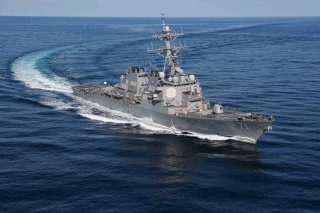How Spy-6 Radar Is Enhancing the Navy’s Next Destroyer
The cornerstone of the Flight III upgrade is the addition of a paradigm-changing AN/SPY-6 (V)1 Air and Missile Defense Radar system.
Several years ago the U.S. Navy put as many as ten DDG 51 Flight III guided-missile destroyers on contract to help catapult the service into a new dimension of maritime attack capability, as the ships have improved weapons, better computing, longer range, and a more sensitive radar system.
The Flight III destroyers, which have been in development now for many years, are engineered to ensure the U.S. Navy stays as China continues to build a fleet of high-tech Type 055 semi-stealth destroyers.
The U.S. Navy recently laid the keel for the USS Jeremiah Denton (DDG 129), the latest Flight III Arleigh Burke-class destroyer to surge into a new phase of production. While the service is currently experimenting with concepts for its next-generation DDG X destroyer, the Flight III destroyers are intended to sail for decades into the future given the sophistication of the ship’s weapons and technology. In fact, early conceptual thinking regarding the new DDG X is that its technological systems, weapons, and radar will be based upon those now integrated into the Flight III destroyer.
The cornerstone of the Flight III upgrade is the addition of a paradigm-changing AN/SPY-6 (V)1 Air and Missile Defense Radar system. According to U.S. Navy and Raytheon developers, this radar is thirty times more sensitive than its predecessor and helps ship commanders detect enemy threats at twice the distance of previous radars. This is quite a leap forward, given that the ranges of enemy weapons and sensors, coupled with multi-domain connectivity and networking, have dramatically increased the threat equation for surface warships.
The SPY-6 family moves beyond existing AN/SPY-1 ship-integrated radar systems and, according to an interesting essay in Microwave Journal ”handles 30 times more targets and has 30-times greater sensitivity than the SPY-1D(V).”
Raytheon’s SPY-6 radar transmitter uses a material known as Gallium Nitride (GaN), a military-grade substance Raytheon developers said is up to 1,000 times more efficient than the Gallium Arsenide used today.
When it comes to application, the SPY-6 radar systems streamline otherwise disparate fire-control and detection technologies. The SPY-6 can cue short-range interceptors as well as ballistic missile interceptors with longer ranges, such as an SM-3. This shortens the sensor-to-shooter time and offers combat commanders a longer window to take countermeasures. This integration is precisely the kind of defense needed to counter a multi-pronged coordinated enemy attack consisting of ballistic and cruise missiles, drone attacks, and more.
With the SPY-1 system, combat commanders can sense threats from greater standoff distances and operate with a larger time window to take countermeasures. The AN/SPY-6 radar is also integrated into the U.S. Navy’s Aegis Combat System, an integrated suite of technologies combining air-and-cruise missile defense with ballistic missile defense, onboard computing, and fire control systems. With more precise threat data arriving more quickly from greater distances, Aegis can incorporate and analyze new streams of precise threat track data with enough time to take countermeasures and determine fire-control coordinates.
The DDG 51 Flight III upgrade is centered on the AN/SPY-6(V)1 Air and Missile Defense Radar and incorporates upgrades to the electrical power and cooling capacity, as well as additional changes to provide enhanced warfighting capabilities to the fleet. Flight III is the latest Flight upgrade in the thirty-year history of the class, building on the proud legacy of Flight I, II, and IIA ships before it.
A U.S. Navy statement also said that HII’s Ingalls Shipbuilding is also producing the USS Lenah Sutcliffe Higbee (DDG 123), USS Jack H. Lucas (DDG 125), USS Ted Stevens (DDG 128) and USS George M. Neal (DDG 131).
Kris Osborn is the defense editor for the National Interest. Osborn previously served at the Pentagon as a Highly Qualified Expert with the Office of the Assistant Secretary of the Army—Acquisition, Logistics & Technology. Osborn has also worked as an anchor and on-air military specialist at national TV networks. He has appeared as a guest military expert on Fox News, MSNBC, The Military Channel, and The History Channel. He also has a Master’s Degree in Comparative Literature from Columbia University.
Image: DVIDS.

